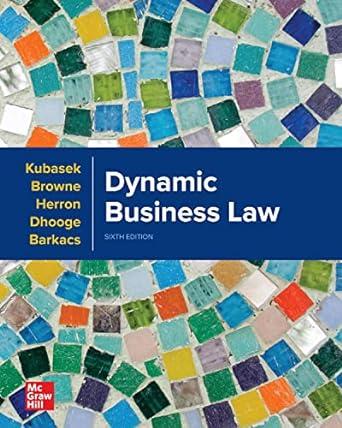Mrs. Palsgraf was waiting for a train on a platform of a railroad. When a different train
Question:
Mrs. Palsgraf was waiting for a train on a platform of a railroad. When a different train came into the station, two men ran to get on that train before it left the station. While one of the men safely reached the train, the other man, who was carrying a package, jumped on the already moving train but seemed as though he was going to fall off the train. The guard on the moving train tried to help pull the man onto the train, while another guard off of the train pushed the man from behind. Consequently, his small package wrapped in newspaper, which contained fireworks, fell upon the rails, causing the fireworks to explode. The shock of the explosion dislodged scales at the other end of the platform, and the falling scales hit Mrs. Palsgraf, causing injuries for which she brought suit against the railroad.
JUDGE CARDOZO Nothing in the situation gave notice that the falling package had in it the potency of peril to persons thus removed. Negligence is not actionable unless it involves the invasion of a legally protected interest, the violation of a right. “Proof of negligence in the air, so to speak, will not do.” If no hazard was apparent to the eye of ordinary vigilance, an act innocent and harmless, at least to outward seeming, with reference to her, did not take to itself the quality of a tort because it happened to be a wrong, though apparently not one involving the risk of bodily insecurity, with reference to someone else. “In every instance, before negligence can be predicated of a given act, back of the act must be sought and found a duty to the individual complaining, the observance of which would have averted or avoided the injury.” “The ideas of negligence and duty are strictly correlative” (Bowen, L. J., in Thomas v. Quartermaine, 18 Q. B.
D. 685, 694).
The argument for the plaintiff is built upon the shifting meanings of such words as “wrong” and “wrongful,” and shares their instability. What the plaintiff must show is “a wrong” to herself, i.e., a violation of her own right, and not merely a wrong to someone else, nor conduct “wrongful” because unsocial, but not “a wrong” to any one. We are told that one who drives at reckless speed through a crowded city street is guilty of a negligent act and, therefore, of a wrongful one irrespective of the consequences. Negligent the act is, and wrongful in the sense that it is unsocial, but wrongful and unsocial in relation to other travelers, only because the eye of vigilance perceives the risk of damage. If the same act were to be committed on a speedway or a race course, it would lose its wrongful quality…. [W]rong is defined in terms of the natural or probable, at least when unintentional (Parrot v. Wells-Fargo Co. [The Nitro-Glycerine Case], 15 Wall.
[U.S.] 524)…. Here, by concession, there was nothing in the situation to suggest to the most cautious mind that the parcel wrapped in newspaper would spread wreckage through the station. If the guard had thrown it down knowingly and willfully, he would not have threatened the plaintiff’s safety, so far as appearances could warn him. His conduct would not have involved, even then, an unreasonable probability of invasion of her bodily security. Liability can be no greater where the act is inadvertent.
Negligence, like risk, is thus a term of relation. Negligence in the abstract, apart from things related, is surely not a tort, if indeed it is understandable at all….
Negligence is not a tort unless it results in the commission of a wrong, and the commission of a wrong imports the violation of a right, in this case, we are told, the right to be protected against interference with one’s bodily security. But bodily security is protected, not against all forms of interference or aggression, but only against some. One who seeks redress at law does not make out a cause of action by showing without more, that there has been damage to his person. If the harm was not willful, he must show that the act as to him had possibilities of danger so many and apparent as to entitle him to be protected against the doing of it, though the harm was unintended. Affront to personalty is still the keynote of the wrong.
The law of causation, remote or proximate, is thus foreign to the case before us. The question of liability is always anterior to the question of the measure of the consequences that go with liability. If there is no tort to be redressed, there is no occasion to consider what damage might be recovered if there were a finding of a tort.
CRITICAL THINKING:
Why does the court believe that Mrs. Palsgraf should not be awarded damages? Are you persuaded by these reasons? Why or why not?
ETHICAL DECISION MAKING:
Think about the WPH process of ethical decision making. It may seem unfair that Mrs. Palsgraf was unable to collect damages for her injuries. Study the list of values or purposes for a decision. Which value do you think the court was upholding through its decision? Which value is in conflict with this favored value?
With which value do you most agree?
Step by Step Answer:

Dynamic Business Law
ISBN: 9781260733976
6th Edition
Authors: Nancy Kubasek, M. Neil Browne, Daniel Herron, Lucien Dhooge, Linda Barkacs





